Text
Jian ware

In the book “Chinese Glazes, Their Origins, Chemistry, and Recreation” by author Nigel Woods, chapter seven talks about the brown ware and black ware in Chinese ceramic history. Providing an in depth chemical insight from geographic location and time period in clay and glaze development.
Jian ware created in Jiangsu, which is located on the south east coast of China near the Yellow Sea. The Jian ware glazes have been excavated as far as the northern Fujian province.Huge kilns called dragon kilns were used to fire thousands of tea bowls in one firing. Dragon kilns are long, narrow, curved forms built on a slope. The fuel used was wood.
Although the glaze percentages for each ingredient are still unknown, it is thought that the glaze is made up mainly of the same clay used to make the tea bowls. A thick coat of wood ash and glaze with iron added to the mix was painted or poured over the surface of the bowl. These were then covered with a large unglazed bowl form turned upside down, called a saggar. The atmosphere inside the saggar then helped the thick layer of glaze create the folds and oil spot textures as it melted on the surface in the heat of the fire. These textured glazes have become well known in Jian ware.
The beginning of the Jian wares was approximately 1000 years ago and lasted into the late 14th century. Variations of gemmokus glazes are still popular in present day ceramics. Both for utilitarian ware and sculptural forms.
Jian ware blackware glazes are interesting in that the similar recipes created so many variant finishes. Two of the most known are the hare’s fur temmokus and the oil spot temmokus. These both were found in the Jian kilns located in Fujian province, The photos below are examples of the glazes mentioned above.

Artist/maker unknown, Chinese. (12th or 13th century; Northern Song (960-1127) or Jin Dynasty (1115-1234), Image: 8/15/2012). Jar. Retrieved from http://library.artstor.org.ezproxy.fhsu.edu:2048/asset/AWSS35953_35953_41351762
Artist/maker unknown, Chinese. Jar. 12th or 13th century; Northern Song (960-1127) or Jin Dynasty (1115-1234), Image: 8/15/2012. Philadelphia Museum of Art Gift of Charles H. Ludington from the George Crofts Collection, 1923 http://www.philamuseum.org/collections/permanent/40801.html. http://library.artstor.org.ezproxy.fhsu.edu:2048/asset/AWSS35953_35953_41351762. Web. 12 Apr 2018

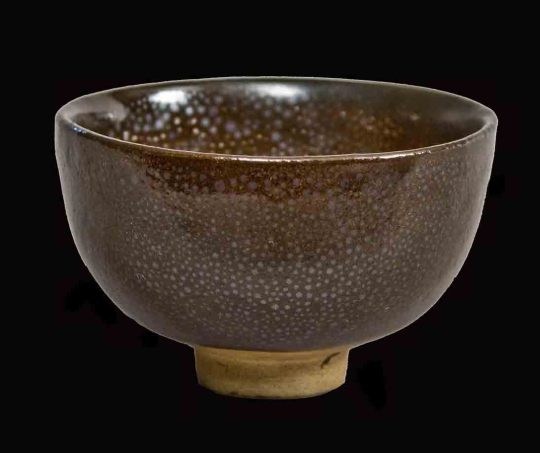


This rare partridge spot glaze was found at the Fujian kiln
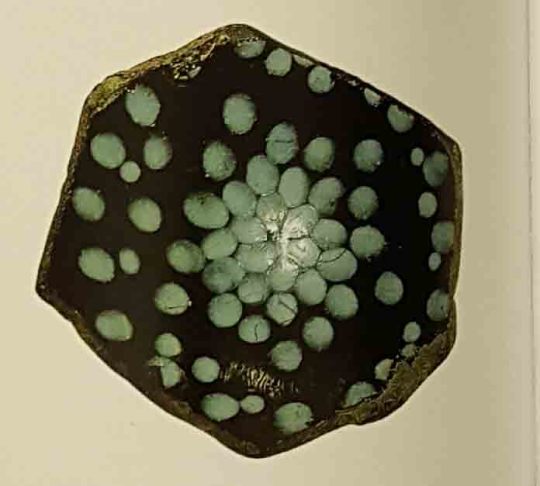

Reading about the bread down of the chemical composition and firing of the dragon kilns provides a great respect of the potters who persevered in the development of the clay body, glaze testing, and discovering how to control the high temperature of the dragon kilns.
These ancient people are role models for present day potters to stay to experiment and develop rich textured glazes for the surfaces of clay forms now.
0 notes
Text
Chinese ceramics part 1
Although ancient human life in China started much earlier than the Paleolithic Era. This short research article is going to start with the development of Chinese ceramics during the Paleolithic Era describing the kind of clay used and where it was found, the form which was made with the clay, and the decoration and firing of the ceramic work. The research will then move forward into the Neolithic Era and compare how fire was more controlled to make the clay more durable, but not yet vitrified.
To clarify the time period, Paleolithic means “Old Stone Age” it is known that only primitive tools were used during this period usually made from stone or bone. Pottery was thought to have been a development in the Neolithic means “New Stone Age” when humans were learning to grow crops and domesticate animals, and they were staying in one area instead of moving with the climate. The idea was as humans started staying in one place they became familiar with getting fire hot enough to vitrify clay. This theory was changed and research is now understanding that there is a blurry line between the nomadic “hunters and gathers” to the agricultural discoveries of growing seeds in crops and then controlling fire to create ceramic forms for storing grain and other items. A few pieces of pottery were uncovered in Xianrendong Cave located in south China’s Jiangxi province. These small fragments were radiocarbon dated to approximately 20,000 years ago. China was using clay to cook with before growing grain and domesticating animals became the life style of humans. This clay vessel discovery changed the date of Chinese clay building to a date approximately 3,000 years earlier than the preexisting “earliest” Chinese discovery. The markings on the clay work were not decorative, but from being set over a fire for cooking the food inside.
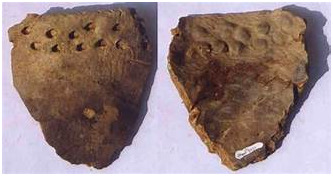
The transformation from nomadic small groups of family tribes to an agricultural larger community of peoples is a diffuse line. The theory is that these small tribes had several specific places they traveled to with the climate. In their movement they met other small tribes and over time exchanged discoveries and about fire, tool making, clay, etc. With these innovations came the knowledge of agriculture, animal husbandry, experimentation with clay and its properties.
Several Neolithic communities have been found along the Yellow River in the Yangshao communities dating around 4800-3000 BCE. The clay pottery is made from low fire clay called earthenware. The clay vessels found are thin walled made by coiling, paddling, and scrapping the walls to smooth them for easy decoration. Rounded pots with a surface decoration painted with an earthenware clay called slip, which is thinning the same earthen ware clay with water to create a paint for decorating the surface of a ceramic vessel. By adding additional minerals to the slip, to make it a darker color the rounded form, decoration is seen more clearly to the eye. The slip was made a darker color by adding additional minerals to it turning the slip decoration almost black when fired. The skill of the makers in this time period is incredible and the techniques are still used today for hand building.
These pots were used as utilitarian ware for storage, and burial urns.

YAPEAX_K@Z��_��r
0 notes
Text
Site Specific Installation: Castle Rock in Kansas
7-10-2016
Site Specific Installation 1
Castle Rock in Kansas: 7-10-2016
Site Specific Installation 1
Title: Community

The birds on the ledge are meant to symbolize a community. The word community is defined in Webster Dictionary, as 1. a body of people in a learned occupation. 2. A group of people living in a particular local area. 3. Common ownership. In all of these definitions, similarity is the reference. Yet, as we look at our society whether at work, or in cities and towns, people can be isolated. When separated from the main community, whether by choice, or circumstance communication with diverse thinking becomes difficult.
Are the groups of birds friends who choose to be together, or are they clustered together because in the work space they’re working towards the same outcome and being close makes the work more efficient.
Do the isolated birds need privacy, or are they being shunned?
Whatever you decide the story is. Remember to be careful with each community member, as if they are on the edge of a cliff, and the wind is blowing strongly.
______________________________________________________________
Title: Castle View

This bird was placed on top of a Kansas Castle Rock formation, inside a rock built nest. Viewers have referred to it as a dragon looking over its possessions.
______________________________________________________________
Title: Emergence
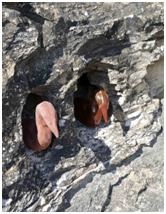
Birds peeking out of side by side indention's in the rock create a humorous feeling of comfort.
0 notes
Text
Partnerships
July 9, 2016
This week, in the summer Ceramics class I’m taking, at Fort Hays State University, we learned about how to create a Specific Site Installation. For those of you wondering what this is, do you remember playing outside when you were young? Using your imagination to make stuff out of sticks, mud, rocks, and any other natural messy thing you could find. Playing in this way created an environment for the story being envisioned. Friends could join in and help with the experience being built.
Specific Site Installation is similar to this, but of course, needs to be more planned than child imagination, using mostly organic materials to create a seemingly natural occurrence, in partnership with the geological setting chosen for the artwork. Each needs to make the other look beautiful, complex, and mysterious.
Working in partnership with another class member, we tried to create a fantasy dress hanging from a tree.
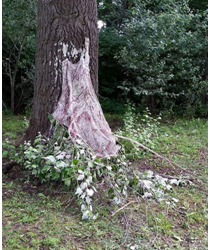
This work is the first try of many to come. Practice will help to develop a personal style that uses the environment chosen, in partnership, with the personal style of the maker(s). Thinking about ways to include more of the landscape so the artist’s concept is more easily understood by the viewer.
Also, when working with a partner in creating an artwork, communication is key……… a well learned lesson this week.
0 notes
Text
Until recently the first early European ceramics was thought to be in the Late Neolithic Period of history. Until 2006, when archeologists found a cave on the edge of a hill, next to Vela Spila, Croatia, on the Adriatic Coast. This cave has been named the “Big Cave,” where thirty six figurines and broken fragments of fired clay were found. The discovery that a tribe of hunters and gatherers were able to create ceramic work was studied and documented to show this tribe played with innovative artistic processes of fire, along with the knowledge of weaving, carving bone, antlers, and ivory, using tools they created. These works are dated to 17,500 cal BP – 15,000 cal BP, in the Upper Paleolithic Period, the Last Ice Age. Innovation and exploration of materials in this time show a socio – technical1 change in the human culture, between the Middle Palaeolithic and Upper Paleolithic Periods. The ceramic work in this cave disappeared 2,500 to 3000 years later, and the knowledge of the clay techniques where lost to this region until a rediscovery in the Neolithic Period. In this same cave examples of Impresso Neolithic pottery were found. These are round bottomed vessels, terra cotta colored, with combed surface decorations. Similar vessels have been found in the area of the Black Sea.
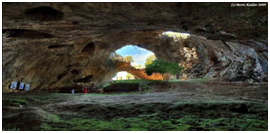
Under the cut, More Ceramic History of Paleolithic and Neolithic Ceramics
The La Gravettian ceramic figurines were also uncovered by archeologists in France. This Venus female figures were created with an over emphasis of the female form, in the Paleolithic Period.
Reading about human’s discovery of clay process from pinching it into a form, and firing it to keep the figures and vessels permanently, is interesting, because it shows the advancement of knowledge and innovation, through experimentation. Using red/brown colorant from different soil to finish the work into an art form, again shows early curiosity for developing symbolic artwork. People discovered this process in different areas of the world, at different time periods. In the article “ First Epigravettian Ceramic Figurines from Europe” (Vela Spila, Croatia) this topic is mentioned briefly. The cave is thought to have been an artistic community for 2,500 to 3000 years, and then the knowledge of processing clay was lost, and discovered again over and over in the history of these early people.
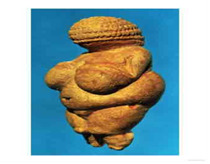
The Neolithic Period is the last stage of the Stone Age in the years of approximately 10,00 B.C – 3000 B.C. The archeology science have documented several cultural inventions, which helped the human culture become more civilized, rather than primitive. The invention of the wheel and the domestication of animals made growing food for groups of people easier. The wheel was also used for the creation of pottery vessels, which were used to store food and water. The ability to do metal working was an important breakthrough, and is paired with the ceramic creation; because of the scientific leap forward of controlling fire with more technical skill than earlier time periods. The primitive culture of the hunter – gatherer population became smaller, as the weather became warmer than in the ice age. The ability to use agriculture, written language, and domesticating animals became the standard for humans in this time period. 2
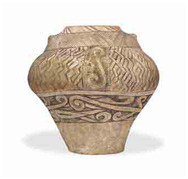
Gordon Childe was an archeologist who studied pre-civilization in the early 20th century. He believed the ceramic items found in the Danube Valley were the consequence of immigration to the area by people from the Mediterranean who arrived in the Balkan area. Childe hypothesis these people migrated through North Africa traveling through the Straits of Gibraltar, which is a channel connecting the Atlantic Ocean and the Mediterranean Sea. It is between Southern Spain and North Africa.
The pottery found in the Danube Valley, Near Vienna Italy is theorized to have been influenced by the ceramic knowledge of this population.
This vessel is a Cucuteni style vessel. The clay was tempered with crushed mussel shells, snail shells and coarse sand. The firing is semi oxidized not being evenly controlled. The surface decoration is created by dragging a jagged tool through the clay to create a multi- lined pattern.
The exact dates of early pottery are difficult to pin down. The discovery of the clay forms in Croatia show how history can be uncertain, but exciting knowing, that as a present day potter, I have something in common with a pre historic person. Imagining sitting down to talk to them about their knowledge of clay and sharing information of newer techniques with them is an idea for this clay person to experiment with.
P>��@]
0 notes
Text
Paleolithic and Neolithic Ceramics in Europe
1 - First Epigravettian Ceramic Figurines from Europe (Vela Spila, Croatia)http://journals.plos.org/plosone/article?id=10.1371/journal.pone.0041437
2 - Neolithic pots and potters in Europe: the end of ‘demic diffusion’ migratory model
Mihael Budja
0 notes
Text
1 - First Epigravettian Ceramic Figurines from Europe (Vela Spila, Croatia)http://journals.plos.org/plosone/article?id=10.1371/journal.pone.0041437
2 - Neolithic pots and potters in Europe: the end of ‘demic diffusion’ migratory model
Mihael Budja
0 notes